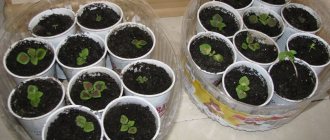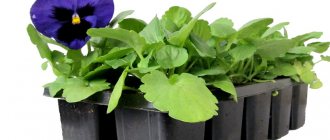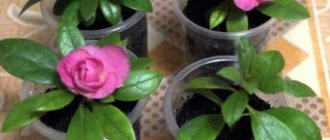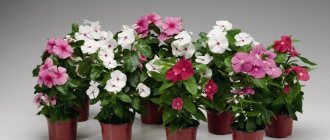Beginners try to grow streptocarpus from seeds at home, since their germination from cuttings and leaves is a process for masters. You can buy flower seeds or collect them yourself. They are planted on top of moist soil, creating greenhouse conditions for the first time. On average, the first results appear after 1-2 weeks. Further proper care will allow you to grow a colorful flower garden of streptocarpus.
Even new varieties of streptocarpus can be grown from seeds
Description of the plant
Streptocarpus is an annual or perennial shrub that grows in the tropical forests of Africa and East Asia. The plant does not tolerate shade at all. Considering the fact that mainly hybrids are grown on window sills, the seed propagation method will not allow the sprouts to inherit the properties of the mother plant. However, among other propagation methods it is considered the most effective.
Streptocarpus is also unique in that it can be made to bloom almost all year round. To do this, artificial conditions for comfortable growth and development are created for him. The ornamental plant has about 130 varieties, which, depending on the type, may differ in appearance and growing conditions. For example, among them there are herbaceous varieties and plants that feel comfortable in a dry climate.
The flowers also differ, which can be simple, semi-double or densely double. Their color can be very diverse; you can grow not only one-color, but also two-color streptocarpus with different types of color. For example, it could be a pale blue flower with dark blue stripes on the lower petals, or a double specimen with a pink top and a milky yellow bottom.
The shape of the petals also differs: depending on the type, it can be pronounced, divided into 5 petals, or terry-corrugated, where the petals seem to be something single, cut along the edges.
Features of preparation
The best seeds are those that are sown immediately after harvest. As a rule, they are the ones that have the greatest germination rate. The seeds themselves are tiny, which is why they are called “seed dust.” If seed is purchased in a store, you can choose between regular and granular seeds.
At the same time, the latter have a nutritious shell, which, although not much, increases the size, making the fit more comfortable. When purchasing, you cannot find out in what conditions the seeds were stored, but you can always see the expiration date. It’s better to rely on it: the fresher the seeds, the more sprouts will sprout. As for the variety, its choice depends on the preferences of the buyer. Beautiful varieties include streptocarpus hybrid “Madagascar” and “Volna”.
Capacity
It is necessary to choose a container for a plant taking into account the root system. In streptocarpus it is superficial, and very quickly fills the pot itself. Therefore, the planting container should be wide and shallow. You can use plastic containers as containers, which can later be cut, minimizing the risk of injury to the roots during transplantation.
Regardless of the type of pot, holes must be made at the bottom for drainage to prevent moisture from stagnating. The holes do not need to be made too large, since drainage will have to be placed on the bottom (for example, broken brick, expanded clay or crushed shards). As for the flower pot, preference is given to light colors.
In summer, the plant will not be hot in such pots, since they will reflect the sun's rays.
Priming
The choice of soil for a plant must be approached carefully. The fact is that it is its composition and fertility that are the reasons why the plant loses its decorative value within two years from the moment of planting. This is explained by the fact that it is quickly depleted due to the extraction of nutrients from it by the flower itself. The soil for streptocarpus should be fertile and loose, its acidity should be about 5.5-6.5 pH.
If you doubt the quality of the soil, you can purchase a ready-made substrate at a specialized store. To grow a flower, a soil mixture for Saintpaulia is perfect, but you must include peat in it. If you want to make the substrate yourself, mix leaf soil, vermiculite (perlite or coarse sand), peat, and crushed sphagnum moss. It would also be useful to add crushed charcoal to the soil.
Landing
The ideal time for sowing streptocarpus for seedlings is considered to be the end of January - beginning of February. This process is painstaking and cannot be rushed. Small bowls are prepared for future seedlings, with drainage at the bottom. Soil or a prepared substrate is poured onto the drainage layer, then the soil is moistened.
Seeds are planted in the soil superficially; they are not covered with soil on top and not deepened into it , although sometimes they are sprayed from above with a fine spray. After planting, the container is covered with plastic film or glass on top to ensure a greenhouse effect. The bowl is removed to a warm place where the temperature is approximately +21-24 degrees.
The first shoots usually appear after a week and a half.
During the entire period of their germination, it is necessary to regularly remove glass or film from the container to ventilate the seedlings . Do not place the container in a dark place, as this can increase germination time and cause the sprouts to reach up in search of the sun. As a result, they will be elongated but weak. Watering at this time is carried out through a tray so as not to wash away the seeds and prevent them from rotting.
As for the stratification of perennials, its relevance should be looked at on the seed packages in the store. If it does not indicate that it is necessary to stratify streptocarpus, there is no point in this procedure. This will not affect germination, because even for perennials, the best and highest quality seeds are those that are planted immediately after ripening.
If the grower believes that stratification is necessary, he keeps the moistened seeds on the bottom shelf of the refrigerator at a low positive temperature.
Streptocarpus does not like either heat or cold, and therefore the optimal temperature for its active growth and development is +20-25 degrees. During flowering, it is desirable that the temperature be a couple of degrees lower. If the house is hot, the flowers will begin to fade. To fix the problem, you can take the flower out into the fresh air.
At the same time, it is worth noting a nuance: large-flowered varieties love more heat (at least +20). Those with small flowers need coolness, and therefore the optimal condition is a temperature of +15. You need a lot of light, but diffused, and the duration of daylight hours should be at least 14 hours.
The best place in the room would be to place the flower on the windowsill of a south-facing window.
Streptocarpus grown from seeds at home must be watered correctly. The flower does not like too much water in the soil. Proper watering consists of moistening the soil so that water does not fall on the leaves and root collar of the plant. In this case, it is necessary to use settled or filtered water at room temperature for irrigation.
Maintenance in winter
It turned out that this is the most pressing question. It was on this subject that the most opinions were expressed, sometimes even opposing ones. And since there was no universal ready-made recipe, you will have to calculate your own optimal option in practice.
Question: Please share your experience of winter keeping streptocarpus. Is additional lighting necessary? In what conditions do strapes overwinter and how do they feel?
Answers:
- In winter, streps are in a state of relative dormancy. I keep them relatively cool at +16...+20C. At higher temperatures, they begin to sag; heat is destructive for streps. For some reason, they weren’t very happy with the additional lighting, so I put them under natural light.
- I have them on a glassed-in loggia, where the temperature is 10-12°C. I water it a little bit, but with warm water (water bottles “live” on the radiator!) 1-2 times a week. And the smallest one stands with violets on a backlit shelf and he doesn’t like it there - the tips of the leaves dry out, although the temperature is 22.5-23oC! Apparently there is not enough humidity.
- Apparently, streps are more sensitive to low humidity. When the air is dry, the tips of the leaves dry out immediately. I keep young rosettes in a tray with moss, they like it better that way. (This answer refers to recommendations for general year-round care; this advice can be used all the time, not just in winter.)
- They grow on a northern windowsill next to orchids; in winter I provide up to 13-14 hours of total daylight. But I focus on orchids. It is better to give streps some rest in winter.
- Mine have been under the lamp for the first year, they like it, now some are blooming, some are growing buds. This had not happened before; they were resting at this time. But you still have to be careful with watering. The temperature on the windowsill is +19+20, the humidity is almost always high, they live in my kitchen, but sometimes I spray fine dust with water and they tolerate it well.
- My only strep guy didn't like it under the lamps. The leaves did not dry out, since our humidity is very high, but the flower stalks stretched twice as long as they should. And the color was distorted. After moving to the windowsill, the flowers turned sharply blue. In my opinion, streps do not like artificial lighting.
- Mine are on a violet rack, but on the lowest shelf. I keep the temperature no higher than 24, periodically when ventilating it drops to 15. The violets mutter (sometimes), but the strapes are okay, they seem happy.
- My gang is standing on the windowsill with orchids. Temperature 12-16 depending on the distance to the glass. I put small change away from the glass, adults closer. Combined lighting: natural + additional lighting. Over the winter they grew leaves. Now all the adults are standing with buds.
- I keep most of the streps on violet racks. Part in the orchidarium, at home. There were no problems at all. At + 18, on racks, in the workroom, strapes generally feel wonderful. The orchidarium has to be sealed tightly, and the temperature there during the day is about +30-33. Children of 5 varieties were placed there after colchicination, obviously weakened, and nothing, alive, just as tall.
- Mine are also on the rack along with the violets under artificial lighting. My humidity is high, nothing dries out, and the flower stalks do not stretch. Why should they stretch out there if there is already plenty of light? Somehow, out of necessity, I placed one strap on the windowsill. The windows are plastic, it doesn’t seem cold there, but he immediately hung his ears. The leaves did not recover later, now new ones are growing on the rack. It's a pity, but it could have bloomed already.
to contents
Possible problems
Like most plants, streptocarpus can become diseased during active growth and dormancy. The main reason for this is non-compliance with the rules of caring for it.
- If a plant is sick with gray rot , then it has suffered from cold or received mechanical damage. Spots and then mold appear on leaves, shoots and flowers. Streptocarpus is saved with a fungicide.
- Fusarium indicates excessive watering and low temperatures that are not suitable for the flower. The cuttings and peduncles begin to rot, and then the roots. If the roots are sick, it is almost impossible to save the plant.
- Drying and deformation of leaves, the appearance of a white coating, and loss of decorativeness of the plant indicate that it is suffering from powdery mildew. This occurs with high humidity, drafts and sudden changes in temperature. It is urgent to treat the flower with a copper-soap solution.
- If growths appear on the leaves, and the foliage itself begins to curl, this indicates an aphid attack. Spider mites appear when the room is hot and dry. Each insect gets rid of it with its own preparation.
- If a plant is attacked by thrips , they will feed on its juices, which will lead to loss of decorativeness and stunting of growth. You need to get rid of pests with Actellik or Akarin.
For information on how to grow streptocarpus from seeds, see below.
Hello, dear readers! Streptocarpus is an annual or perennial herbaceous shrub. Its name is translated from Greek as “twisted fruit.” Indeed, streptocarpus boxes have this shape. Streptocarpus is rightfully considered an ornamental plant.
In addition, it grows great at home, its flowers look beautiful and do not fall off for a long time. Tiny seeds ripen inside the twisted boxes. Well, why not try to plant them?!
Streptocarpus from seeds. Preservation of varietal characteristics
Question: Please tell me what difficulties arise when growing streptocarpus from seeds? Is the technology very different from growing gloxinia from seeds? When is the best time to sow them?
Answer: Let's start with the last question, about sowing dates. If you plan to use natural light, it is best to sow no earlier than February. However, if there is the possibility of backlighting, the question of timing is removed.
If you have seeds, then they are probably in granules. It's easier with granules. Do not deepen them too much; lightly sprinkle them with sand or fine agroperlite. Keep in a greenhouse, slightly moistening the surface. When they grow a little, be sure to dive. It is best to put it in a warm place +22...24C. Streps are very fond of natural light, but backlighting (especially when the daylight hours are shortening) will not hurt.
Seedlings need to be planted in light soil. It is better to take “Vermion” for seedlings and flowers or “Elite for violets” as a basis. Select expanded clay from there and add a little perlite and vermiculite. (If there are no such ready-made soils, see mixtures for rooting cuttings.)
Question: How long after sowing do streps grown from seeds bloom? When does the first flower appear? When can we expect the first full flowering?
Answer: Provided that the seeds were sown in February-March, the first flowering occurred after 5-6 months. This is taking into account the timely picking. If you are late, the development of seedlings is inhibited. Well, since the first flower bloomed just before winter, full flowering occurred the following year.
Question: Do seedlings need fertilizing?
Answer: According to subjective data, streptocarpus, like other Gesneriaceae, are not particularly demanding when it comes to feeding. 1/3-1/4 of the usual dose of complex fertilizer is enough, once every 1.5-2 weeks. You can spray a little. In seedlings it gets on both the tops and roots.
Question: Can streps exercise? They say no. Even the fantasy coloring is conveyed well.
Answer: Not everything is so simple. Bud mutations (sports) are known in most cultivated plants. In some they occur less frequently, in others more often (snapdragon, evening primrose). Violet is a record holder in this regard.
Among streps, sports occur much less frequently, but they do occur.
- "Maassen's White" is highlighted as a sport from "Constant Nymph"
- "GLORIA" from "Falling Stars"
- "GWEN" from "Bethan".
If there were no sports, such amazing genetic diversity would not have accumulated.
Question: Will varietal characteristics be preserved during pollination of streps or will splitting occur - after all, there are now many varietal plants?
Answer: Varietal characteristics will not be preserved!
All plant varieties are hybrids. When grown from seeds, even pollinated by the same variety, you will get a set of new hybrid seedlings. At best there will be variations on the theme of the parent variety. But successful seedlings can turn out to be completely different and at the same time very impressive. For which they can even be awarded their own name!!! However, before giving a name to a “new variety,” carefully review the other varieties of the author’s parent plant and make sure that the varietal characteristics are preserved during further vegetative propagation.
to contents
Seed selection
To date, a huge number of different varieties of streptocarpus have been bred. When you go to the websites of online flower shops, your eyes widen! There were not so many types of flowers even on the plant’s homeland, the island of Madagascar. There is such a variety of colors that it’s time to buy the ones you like the most and dedicate an entire window sill to this collection.
But we must remember that streptocarpus has one feature. When propagated by seeds, new shoots do not always inherit the properties of the mother plant. This is because, as a rule, all parent plants are hybrids.
However, if you want to get a large number of sprouts, then you will not find a better way than seed propagation. This is how this plant is bred in flower shops.
Those seeds that are sown immediately after harvest have the maximum germination rate. It is best to extract seeds from fruits in the spring and plant them immediately. But any gardener is familiar with the situation: you want to get one or another variety, for example, “Wave” or “Dancing Flame,” but other than ordering seeds, there is nowhere to get it.
Well, we purchase and sow at home! But first, let's figure out how to grow streptocarpus from seeds.
Features of streptocarpus propagation by seeds
Streptocarpus has its own characteristics if grown from seeds at home. Among them are:
- Producing a unique result that is unlikely to be similar to the parent plant. The flower may have a different color, appearance, and perhaps even the development of a new variety of streptocarpus.
- Growing a flower from a seed is a long but interesting process. It cannot be called labor-intensive, but you will have to take into account many details that are important for a beautiful and healthy result.
- Streptocarpus seeds are so small that they are comparable only to grains of sand. For this reason, they are not planted in the ground, but scattered on the ground. Later, when the sprouts become stronger, they begin picking, i.e., planting.
- Streptocarpus is one of the few flowers that is ready to bloom all year round under a regular incandescent lamp, i.e. using artificial lighting. At first, greenhouse conditions are created for the seeds, then they are “accustomed” to the outside world.
Where to get streptocarpus seeds
Streptocarpus seeds are bought at a flower shop. It is important to pay attention to the date of their collection. The fresher they are, the faster the germination process will be. The older you get, the more patient the grower needs to be, because the first results will not be noticeable soon.
The seeds look more like grains of dust and sand. Despite the "parent", they can turn into a different flower with different characteristics. Therefore, to this day, flower growers are discovering new species of streptocarpus.
How to collect streptocarpus seeds yourself
To obtain seeds from streptocarpus, the mother plant must be pollinated. Many gardeners do this with a needle. The stamens of the flower are carefully opened with a needle, which is enveloped in pollen. It is applied to the pestles. After about a month (times vary), seed boxes appear, which are not touched until they ripen. They should dry out a little, or the stem itself dries out. In this case, the box is left for some time (the count goes for a week or more) until it dries completely.
Read more How to propagate streptocarpus from a leaf: how to root, how to plant, how to grow, video
Seeds can be purchased and also collected from a pollinated flower.
Considering that streptocarpus seeds are microscopic, the boxes are opened over a piece of paper, excluding a draft in the room. Some gardeners then mix the seeds with sand to distribute them more evenly throughout the soil.
Planting seeds
If you have never grown streptocarpus from seeds before, keep in mind that each seed is so small that it is impossible to see it without a magnifying glass. The pods can be said to contain "seed dust" rather than seeds.
However, every speck of dust like this eventually turns into a full-fledged plant. But bags from the store may also contain seeds in granules, which are more convenient to work with.
To grow a flower from seeds, it is best to use a plastic container with a lid. Be sure to make several holes in the lid to allow air access to the seeds.
Before planting the seeds, add a layer of perlite or vermiculite to the bottom of the container and moisten it.
Then add a layer of substrate on top of this layer. To obtain the substrate, it is best to use tablets, for example, Jiffy. They contain all the necessary nutrients for rapid seed germination and seedling growth. It is more convenient to use large tablets with a diameter of 5 centimeters.
In such tablets, a fine-grained substrate is compressed with a small addition of coconut fiber. Fill the tablet with warm boiled water, without removing it from the mesh, and wait until it swells.
After this, squeeze out the excess water, cut the mesh and evenly distribute the substrate over the perlite layer.
How to plant streptocarpus with seeds
Freshly harvested seeds will give the best germination. They should be handled with the utmost care, including during the process of germination. When it's time to water, don't use a regular bottle or watering can. The use of a sprayer should also be controlled, i.e. spraying is done not with a stream, but with a spray. Otherwise, seeds and sprouts may be damaged.
Deadlines
It is better to plant in the spring, from about the end of February to April. The fact is that the plant needs warmth to germinate. The gradually warming spring sun will promote their best growth. However, streptocarpus will take root well under an artificial sun, which can be an ordinary incandescent lamp, since it not only illuminates, but also provides warmth.
If planted correctly, the first shoots can sprout within a week. It is noteworthy that the gardener may not notice them, since they are very small. Therefore, it is recommended to get a magnifying glass at least for the first time. After a month, tiny petals are visible to the naked eye. Ultimately, the first seedlings bloom after 9 months, sometimes later.
Preparing containers and soil
If the grower intends to prepare the soil himself, then there are several options for compositions, taking into account the proportions:
- deciduous soil, peat, sand in a ratio of 2:1:1;
- peat, perlite, sphagnum moss in proportions 1:1:1;
- high-moor peat, leaf humus, perlite or vermiculite, sphagnum moss in a ratio of 2:1:0.5:0.5.
For beginners, flower growers recommend using the so-called peat tablet. According to the instructions, it is poured with boiling water, but experts advise immersing it in warm boiled water, so it will retain its beneficial properties. Perlite or vermiculite is poured onto the bottom of the container or pot, and the substrate is placed on top.
Attention! There is no need to compact the soil; on the contrary, you need to loosen it. Seeds should germinate freely.
One of the important steps for growing streptocarpus is regular replanting.
A plastic container, covered with a lid with holes for air circulation, or a solid container, but you will have to constantly wash off the condensation, is suitable as a container for sowing. Next, when the time comes to transplant, you need to select pots - the ratio of diameter to height is 1.5 to 1.
More details Streptocarpus: photos of flowers with names and descriptions, video
Rules for sowing streptocarpus seeds
The seeds themselves do not need preparation; they do not need to be soaked, dried, etc. in advance. Seeds are carefully sprinkled onto previously prepared moistened soil. It is not recommended to pour it in a pile, otherwise further seating will be difficult. Usually they use paper to distribute them evenly. Some gardeners mix the seeds with sand, which makes sowing easier.
Attention! Seedlings are not sprinkled with peat on top. The maximum manipulation after sowing is to lightly press them to the ground with a spoon.
Cover the container with a lid and place it in a bright place, but not in direct sunlight. If there is condensation on the lid, it must be removed and the box ventilated. When the seedlings appear, you need to make the first pick, which consists of sifting tiny seedlings away from each other in the same container or in another one. When the soil begins to dry out, you need to spray water from a sprinkler.
After another month, when the seedlings increase in size, they are regularly transplanted into more suitable pots or containers. After about nine months, full-fledged flowers grow from the seeds, which are less demanding to care for.
We are waiting for sprouts
Sometimes it happens that drops of condensation appear on the bottom surface of the container lid. This happens if the soil for sowing is too wet. In this case, remove the lid and ventilate the container. After a couple of minutes, return it to its place.
How long does it take for Streptocarpus seeds to germinate? They usually germinate on the ninth day after planting. In this case, the sprouts appear tiny, and without a magnifying glass they may not be noticed. You should have one, since the first transplant of sprouts will not be possible without a magnifying glass.
And you will have to replant streptocarpus sprouts often, since without this it will grow extremely slowly. It is best to separate the sprouts from the total mass of sprouts with a regular toothpick. Transfer them to a new place with tweezers or the same toothpick. Make the first transplant a month after sowing.
In the future, it can be done as needed. As you can see, sprouts require painstaking care.
But when to plant streptocarpus with seeds, there is no difference, because it is able to bloom in winter and summer.
How to water
Water the crops only using a spray bottle. The fact is that the seeds and first shoots are so small that even the thinnest stream of water will simply wash them away.
That is, you will have to carry out spraying rather than watering. The water mist does not need to be directed directly onto the substrate. Spray water over the container.
If you master this delicate work, the flower will grow, become stronger and become your pride. Not only will you get a rare specimen that no one you know has, but you will also gain experience in growing it.
Streptocarpus obtained from seed blooms only 8-9 months after planting. You won't have to wait that long for your miracle!
Streptocarpus or streptocarpella is a beautiful indoor flower from the Gesneriaceae family. The island of Madagascar is considered the birthplace of the plant; it can be found in the wild in South Africa and Asia. In total, about 130 species of flower have been recorded; it gets along well at home and can serve as a decoration for any greenhouse or garden. Streptocarpus got its name due to the unusual shape of the seed pods.
After the streptocarpus flower withers and the seeds ripen, the capsule curls into a bizarre shape. Translated from Greek, “streptus” means a twisted spiral, and “karpos” means a fruit, a seed. The flower first became known in Europe in 1818 thanks to the botanist James Bowie. Then it was called “Didimocarpus rexii”, but very soon it was renamed “Streptocarpus rexii”. The plant is still known by this name today. If more than a hundred of its varieties can be found in the wild, then more than a thousand cultivated hybrids are known.
Description
Streptocarpus "Jana" during flowering.
Streptocarpus has the shape of a rosette of large, fleshy, oblong leaves of a dark green color. The length of one leaf can reach 25 cm, and the width - 7-8 cm; the stems of the plant are very short and covered with fluffy pile. In the center of the rosette are beautiful, bright bell-shaped flowers with curved petals.
The plant is distinguished by abundant flowering - one specimen can produce up to hundreds of buds. The color of the flower is very diverse - from white and blue to purple and dark lilac.
Streptocarpella is loved by gardeners, both professionals and beginners. If you are lucky enough to get to the exhibition of these indoor plants, the impressions will be the most vivid. The most popular varieties are those that combine two or three colors.
You can see specimens with two or three petals with stripes or dots, with a fringed or corrugated edge. One of the most common species is Streptocarpus "Jana". The size of flowers and their number on one bush may vary.
The concepts of “baby” and “delenka”
Question: What is the difference between streptocarpus babies and divisions?
Answers: I won’t say for sure, but, in my opinion, a baby is a new plant on the mother leaf (in the beginning there is only one small leaf) during leaf propagation. And delenka is when a large bush is divided into separate rosettes. That is, the plant is practically an adult. A baby, of course, will die more easily if not cared for properly.
It seems to me that the division may bloom faster. If you want to suffer less and enjoy flowers faster, you need to share. And with the baby before flowering you will have to tinker a little longer! Although children are also pleased with the flowering (and what else!) in the first six months of life.
As a rule, the term “division” is used by sellers. In this sense, a delenka is a fragment of a streptocarpus leaf with germinated children, but their size does not yet allow them to be planted and allowed to “swim” independently. Those. at least a month before leaving the leaf.
Babies also come in different sizes. If the baby is large (leaves about 8 cm), then it can please you with flowering in a month or two.
Straps have growth points as such from one to several. Over time, the bush seems to spread, i.e. is growing. There comes a time when the plant grows to such a size that the pot becomes small. Instead of taking a larger pot, you can divide the “bush” (like, for example, a peony bush), leaving a growing point in each division. By the way, this is another method of reproduction. But it is better to carry it out in the spring, so that stress is more easily experienced.
Here are first-hand impressions on this topic: “In the fall, I tried to divide; out of five dividing pots, only 2 survived, despite all my efforts. I also noticed that after abundant flowering they stop actively growing foliage. I cut off all the old leaves and planted them in small pots in fresh soil. I read that streps love to be nursed, pruned, replanted... As a result, in the fall - again a bunch of pots with babies. And if there is nothing to divide, you can simply replant and be patient until next spring. The main thing is to survive the winter with them!!!”
to contents
Growing at home
Although this indoor culture belongs to the Gesneriaceae family, the breeding and reproduction of streptocarpus is not the same as that of violets. They need completely different care at home.
Lighting
A visitor from Madagascar needs a lot of light. He needs to be provided with 14 hours of daylight, even in winter.
In summer, streptocarpus will feel great on a windowsill or near a window on a stand. But in winter they will have to be illuminated. Experts recommend alternating a fluorescent lamp and a phytolamp.
Bright multi-colored buds of streptocarpus of different varieties.
Temperature
Streptocarpella loves not only warmth, but also light. In order for the plant to feel cozy and enjoy lush flowering, the temperature should be maintained at least 23 degrees Celsius in the summer, and at least 15 degrees in the winter months.
In summer, you need to protect the flowers from direct sunlight and overheating, as they will begin to fade. And in winter, daylight hours can be reduced to 8 hours and fertilizing stopped - the plant enters a dormant period.
Humidity level
Excess moisture will only be harmful to this flower; it tolerates drought normally. Watering should be regular, but only when the top layer of soil in the pot is completely dry. If you water the plant too often, its roots will begin to rot.
In the summer, streptocarpella may wilt a little. In this case, it should be watered moderately every 2 hours three times a day. Such an event will be enough for the plant to fully recover. Streptocarpus will like spraying much more than frequent and abundant watering, even in the heat.
Diseases and pests
Diseases can occur due to unsuitable conditions, as well as due to the presence of pests.
Some causes of diseases:
- First of all, it is worth noting that the plant is not placed in direct sunlight, otherwise the foliage will get burned.
- If the air humidity is too low, the Streptocarpus foliage dries from the tips.
- If the foliage has dried out of season, it means that the plant is not provided with optimal humidity, plus the room is not ventilated.
- A rusty coating indicates that the flowers are crowded in the pot or among themselves, it is overwatered, or an excessive dose of nitrogen fertilizer is used.
From an excess of moisture in the soil, midges appear, pests appear - thrips, spider mites, aphids.
In some cases, you have to trim the flower, in others - treat it with folk or biological means (besides, they will benefit streptocarpus).
Care instructions
Streptocarpus flowers are very delicate and sensitive, but, nevertheless, if streptocarpus appears in the house, caring for it will not require much effort and time. The first rule to remember: you will have to regularly spend time transplanting streptocarpus, he really likes it. To prevent the plant from being damaged, it is recommended to adhere to the following rules:
- select a new pot of larger diameter as soon as there is too little space in the old one for the overgrown outlet;
- a large plant needs to be divided into several parts with roots, each planted separately;
- after this, for seven days, the streptocarpella flower is watered daily in a superficial way. Then they switch to watering through the pan.
- the size of the pot should be at least one and a half times larger than the size of the plant, otherwise very soon you will have to replant it again;
- First, a drainage layer is placed on the bottom of the pot, and then a light substrate.
If brown spots appear on the leaves of the plant, this means that watering is too frequent and its roots are beginning to rot. In this case, the plant needs to be replanted by removing the rotten parts of the root system. It’s better to plant cuttings.
Flowering and care after it
Question: How long does streps bloom?
Answer: Streps, with good care, can bloom almost all year round, well, at least for nine months.
Question: The streps bloomed for the first time, and now the stem of the flower is sticking out, what should I do with it, tear it off or wait for it to dry up?
Answer: Peduncles need to be trimmed, not broken off or torn off. Firstly, unlike violets, they are quite hard, and secondly, dormant flower buds can be damaged, and, perhaps, the leaf itself.
Question: Streps was covered with a cap of flowers all summer. They watered it with “Pocon for flowering” plants. But the leaves stopped growing. The picture is this: old large leaves with dry stumps of cut peduncles and small twisted young leaves that do not want to develop. What to do? Feed him something for the leaves? Or trim off all the big old leaves to encourage new growth? But scary! What if it doesn’t stimulate? Or divide and replant? But autumn is just around the corner. It seems like this is not the time... What to do?
Answer: your action plan:
- Check for pests.
- Replant into fresh soil (if the bush can be divided, divide).
- Trim off old leaves.
- Two weeks after transplantation, feed with fertilizer to increase the vegetative mass.
- It is advisable to put it under lighting.
to contents
Reproduction methods
Streptocarpus propagates from seeds, cuttings or by planting. If you want to get a young, beautiful and healthy flower, propagation by cuttings is best suited. But you will have to try hard for this.
The process of rooting a streptocarpus leaf.
Cuttings
You can break off a large leaf of a violet, place it in a glass of water and just wait for the roots to appear. With this same culture, everything is much more complicated.
- Cut a sheet 5-7 cm long. If all the sheets are very large, you can cut off only half or a third of it.
- Then the leaf is cut crosswise into pieces no more than 2 cm long. On each piece, on one side, a base is made that resembles a stem - this will make it more convenient to immerse the leaf in a glass of water and root it.
- After this, the leaves are placed in small containers with water - it is convenient to use disposable cups.
- Some users advise that instead of water, immediately pour a substrate of peat, perlite, sphagnum and vermiculite into the cups. The leaf is immersed into the substrate with its stem no deeper than 1 cm and pressed.
- After this, the cups are placed in a warm place, they are regularly watered until the “babies” - young small leaves - are thrown out. When there are 2-3 of them, you need to plant the leaves in other cups.
Young streptocarpus obtained by dividing a leaf.
Experienced gardeners can try to make cuttings not from a whole leaf, but only from its central part, the stem, cutting off everything else. This way, many more shoots appear, but it is also harder for the cuttings to take root, so only real professionals can do this task.
Streptocarpus from seeds
It is even more difficult to obtain viable streptocarpus from seeds. But if you have time and desire, it’s worth experimenting. You can breed a completely new streptocarpus from seeds, call it by your own name - as, for example, they called the plant variety “Yana” - and present it at the next international exhibition as a new hybrid variety - isn’t it tempting?
To get seeds, you need two copies of the plant. They must pollinate each other. After the seed box has matured, it needs to be opened and the raw materials for sowing collected. The seeds should be planted not in the substrate, but in peat humus tablets. To do this, they are pre-soaked and then mixed. Then proceed as follows:
- a thin layer of drainage is poured into the container;
- the substrate from the tablets is distributed on top;
- sow seeds;
- cover with a second thin layer of substrate.
Propagation of streptocarpus by seeds - seedlings take a little more than a month.
The container should be covered with film or a cap, placed in a warm and bright place and wait two weeks. By this time, sprouts should appear. Seedlings are picked twice until they are large enough to be planted in separate pots. The first flowers can be expected in about 6-8 months.
Dishes for streptocarpus
Question: How to choose the right container for planting streptocarpus? What should be the correspondence between diameter and height? Does the ratio of foliage diameter to pot diameter apply to them, somewhere around 2-3:1?
Answer: There is no correspondence as such. Pots for plants are selected based on their biological characteristics. Streptocarpus have a superficial root system, so it is better to choose flat pots for them, i.e. the diameter is greater than the height or, in extreme cases, equal to it. During the life of the plant, it will require containers from 5 to 9 cm in diameter. We place the children in pots with a diameter of 5 cm. When it clearly begins to seem that the plant is cramped, we transplant it into a pot one number larger. And so on until the adult state, until the specimen grows to a pot measuring 9x7-8 cm. My streptocarpus did not like pots higher than 8-9 cm, despite the fact that the excess volume was occupied by drainage. Dissatisfaction manifested itself in the refusal of flowering and shredding of leaves, plus the general depressed appearance of the plant. The situation was saved by transplanting into pots of the required size.
to contents
| Rooting in perlite. Photo by: Elenium. |
Rooting cuttings
Question: In what soil mixture is it best to root streptocarpus?
Answer: Several soil mixtures for rooting are recommended:
- A mixture of soil and vermiculite or perlite. Deepen the leaf by 5 mm, strengthen it on both sides with damp sphagnum so that it stands at an angle.
- 1 part peat humus tablet, 0.5 perlite, 0.5 sphagnum.
- Perlite + sphagnum. Mix perlite with water until it becomes a paste, add sphagnum moss to make it thicker. For comparison, the second batch was rooted in a light soil mixture. The children turned out faster in the first version.
- Pure large agroperlite without additives. When watering, just like regular soil, all the water is drained onto a bed of crushed coconut shavings.
- 2 parts of Jiffy-7 peat humus tablets, one part each of vermiculite, agroperlite, cut sphagnum moss.
- Contents of Jiffy-7 tablet.
Attention: Containers with planted cuttings must be placed in a greenhouse!
Question: Tell us about the toaster or boat planting methods.
Answer: When using the “toaster” (“boat”) method, the sheet is removed from the sheet plate). We throw away the vein, it will no longer be needed, the two halves formed are of interest. The sections can be slightly dried (10 minutes). Plant with the cuts down, not allowing a depth of more than 1 cm. Naturally, the soil must be very loose and watering must be moderate, otherwise the process of rotting will begin rather than rooting.
| Planting using the “toaster” method. Author of the photo: Bugira (Moscow). |
With the traditional planting method, when the leaf is cut crosswise, it is better to make a wedge-shaped rather than a straight cut. The guides are the leaf veins extending from the central vein. In size, it is enough to cut fragments 3-4 cm long. You can plant the entire leaf, but usually everyone tries to save space.
Comparison of two planting methods . Experience shows that more children are obtained when planting using the “toaster” method. But due to the fact that there are many of them, development slows down compared to babies obtained from a sheet cut crosswise. In the second case, there are fewer children, but they are stronger. However, every coin has two sides, and here too you need to take into account your goals. If you need to propagate a variety in large quantities from a single leaf, then the “toaster” method is simply irreplaceable.
to contents











